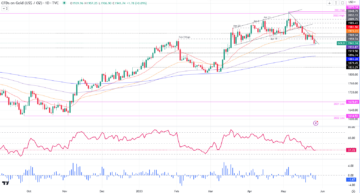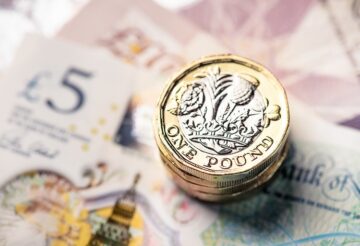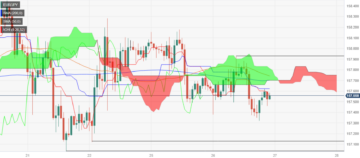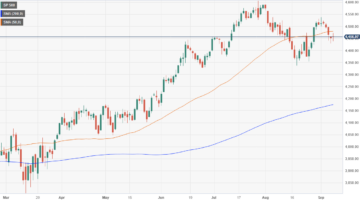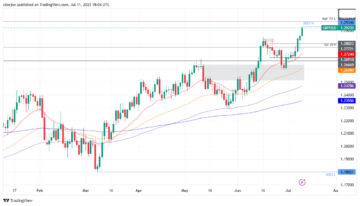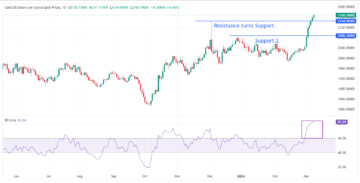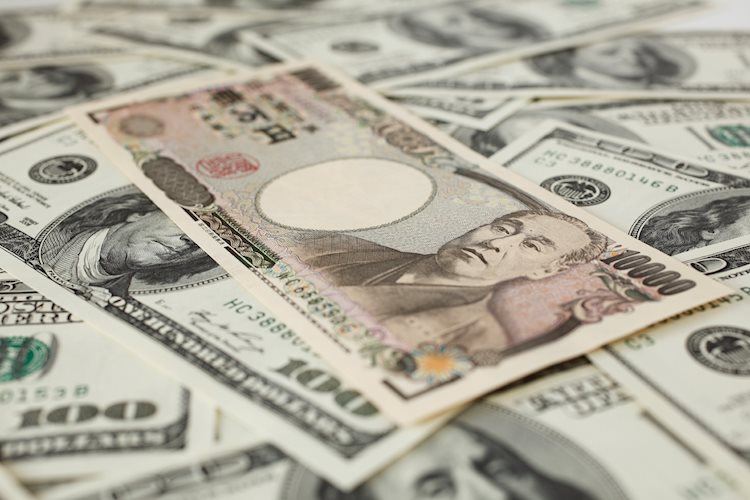
- The Japanese Yen attracts strong buying and snaps a seven-day losing streak to the YTD low.
- The upbeat domestic macro data and BoJ rate hike speculations provide a boost to the JPY.
- The post-FOMC USD selling bias further contributes to the intraday fall in the USD/JPY pair.
The Japanese Yen (JPY) gains strong positive traction during the Asian session on Thursday and recovers further from its lowest level since November 2023 touched the previous day. The Bank of Japan (BoJ) reportedly is weighing the next rate increase in July, though the October hike is considered as one of the most likely scenarios. This, along with the upbeat economic data from Japan, provides a goodish lift to the JPY amid speculations that Japanese authorities might intervene to stem any further weakness in the domestic currency.
The US Dollar (USD), on the other hand, adds to the overnight losses led by the Federal Reserve’s (Fed) dovish hold, which, in turn, is seen as another factor exerting downward pressure on the USD/JPY pair. Meanwhile, the BoJ indicated earlier this week that financial conditions would remain accommodative and fell short of offering any guidance about future policy steps, or the pace of policy normalization. This might hold back the JPY bulls from placing aggressive bets and help limit any further losses for the currency pair.
Daily Digest Market Movers: Japanese Yen draws support from upbeat domestic data and weaker USD
- A Bank of Japan source told the Nikkei newspaper that an early rate hike leaves room to consider rolling out another increase before the end of the year, which, in turn, boosts the Japanese Yen.
- The monthly Reuters Tankan survey showed that confidence at big Japanese companies rebounded to a three-month high in March and the service-sector mood rose to a seven-month high.
- The headline manufacturers’ sentiment index jumped to 10 in March from -1 the previous month, while service-sector sentiment rose to 32 during the reported month from 26 in February.
- Other data released this Thursday showed that Japan’s exports grew more than expected, by the 7.8% YoY rate in February, leading to a fall in the trade deficit to ¥379.4 billion from ¥1.7 trillion.
- The flash au Jibun Bank Japan Manufacturing PMI rose to 48.2 in March from 47.2 in February, suggesting that the pace of deterioration in the factory activity was the softest in four months.
- Adding to this, the au Jibun Bank flash services PMI rose to 54.9 in March, the highest since last May, from 52.9 in February, indicating that service providers maintained a brisk pace of expansion.
- Japan’s Finance Minister Shunichi Suzuki said that it is important for currencies to move in a stable manner and that he is closely watching foreign exchange moves with a high sense of urgency.
- This comes a day after the BoJ’s historic move to raise the short-term interest rates for the first time since 2007 and ditch years of unconventional easing in a shift towards normalising monetary policy.
- BoJ Governor Kazuo Ueda said that the central bank will support the economy and prices by maintaining accommodative monetary conditions and medium, long-term inflation expectations are heading toward 2%.
- The Federal Reserve signalled that it remains on track for three interest rate cuts this year, easing market jitters that the central bank will lower its projection for the number of interest rate cuts in 2024 to two.
- In the post-meeting press conference, Fed Chair Jerome Powell said that the recent high inflation readings had not changed the underlying story of easing price pressures, though kept officials on a cautious footing.
- The US Dollar extends the previous day’s post-FOMC pullback from a two-week high and drifts lower for the second straight day, which is seen as another factor exerting downward pressure on the USD/JPY pair.
Technical Analysis: USD/JPY could extend the corrective decline further towards the 150.00 mark
From a technical perspective, the sharp intraday decline drags spot prices below the 150.80 strong resistance breakpoint turned support, and the 23.6% Fibonacci retracement level of the recent rally witnessed over the past week or so. This might have set the stage for a further intraday depreciating move towards the 150.00 psychological mark, representing the 100-hour Simple Moving Average (SMA). This is closely followed by the 38.2% Fibo. level, around the 149.75 region, which, if broken decisively, could accelerate the fall further towards the 149.25-149.15 region, or the 50% Fibo. level.
On the flip side, the 150.90-151.00 zone now seems to act as an immediate strong barrier, above which the USD/JPY pair could make a fresh attempt to challenge the multi-decade high, around the 152.00 mark touched in November 2023. Some follow-through buying will be seen as a fresh trigger for bullish traders and pave the way for an extension of the longer-term uptrend witnessed since January 2023.
Japanese Yen FAQs
The Japanese Yen (JPY) is one of the world’s most traded currencies. Its value is broadly determined by the performance of the Japanese economy, but more specifically by the Bank of Japan’s policy, the differential between Japanese and US bond yields, or risk sentiment among traders, among other factors.
One of the Bank of Japan’s mandates is currency control, so its moves are key for the Yen. The BoJ has directly intervened in currency markets sometimes, generally to lower the value of the Yen, although it refrains from doing it often due to political concerns of its main trading partners. The current BoJ ultra-loose monetary policy, based on massive stimulus to the economy, has caused the Yen to depreciate against its main currency peers. This process has exacerbated more recently due to an increasing policy divergence between the Bank of Japan and other main central banks, which have opted to increase interest rates sharply to fight decades-high levels of inflation.
The BoJ’s stance of sticking to ultra-loose monetary policy has led to a widening policy divergence with other central banks, particularly with the US Federal Reserve. This supports a widening of the differential between the 10-year US and Japanese bonds, which favors the US Dollar against the Japanese Yen.
The Japanese Yen is often seen as a safe-haven investment. This means that in times of market stress, investors are more likely to put their money in the Japanese currency due to its supposed reliability and stability. Turbulent times are likely to strengthen the Yen’s value against other currencies seen as more risky to invest in.
- SEO Powered Content & PR Distribution. Get Amplified Today.
- PlatoData.Network Vertical Generative Ai. Empower Yourself. Access Here.
- PlatoAiStream. Web3 Intelligence. Knowledge Amplified. Access Here.
- PlatoESG. Carbon, CleanTech, Energy, Environment, Solar, Waste Management. Access Here.
- PlatoHealth. Biotech and Clinical Trials Intelligence. Access Here.
- Source: https://www.fxstreet.com/news/japanese-yen-rebounds-swiftly-after-the-post-boj-slump-to-ytd-low-on-wednesday-202403210230
- :has
- :is
- :not
- 00
- 10
- 11
- 15%
- 150
- 152
- 2%
- 2007
- 2023
- 2024
- 21
- 23
- 26
- 32
- 4
- 48
- 5
- 52
- 54
- 6
- 7
- 75
- 80
- 9
- a
- About
- above
- accelerate
- Act
- activity
- Adds
- After
- against
- aggressive
- along
- Although
- Amid
- among
- an
- analysis
- and
- Another
- any
- ARE
- around
- AS
- asian
- At
- attempt
- Attracts
- Authorities
- average
- back
- Bank
- bank of japan
- Bank of Japan (BoJ)
- Banks
- barrier
- based
- BE
- before
- below
- Bets
- between
- bias
- Big
- Billion
- boj
- bond
- Bond yields
- Bonds
- boost
- boosts
- breakpoint
- broadly
- Broken
- Bullish
- Bulls
- but
- Buying
- by
- caused
- cautious
- central
- Central Bank
- Central Banks
- Chair
- challenge
- changed
- checked
- closely
- comes
- Companies
- Concerns
- conditions
- Conference
- confidence
- Consider
- considered
- contributes
- control
- could
- currencies
- Currency
- currency markets
- Current
- cuts
- data
- day
- Decline
- DEFICIT
- depreciate
- determined
- Digest
- directly
- ditch
- Divergence
- doing
- Dollar
- Domestic
- Dovish
- downward
- draws
- due
- during
- Earlier
- Early
- easing
- Economic
- economy
- end
- exchange
- expansion
- expectations
- expected
- exports
- extend
- extends
- extension
- factor
- factors
- factory
- Fall
- FAQ
- favors
- February
- Fed
- Fed Chair
- Fed Chair Jerome Powell
- Federal
- federal reserve
- Fibonacci
- fight
- finance
- FINANCE MINISTER
- Finance Minister Shunichi Suzuki
- financial
- First
- first time
- Flash
- Flip
- followed
- For
- foreign
- foreign exchange
- forex
- four
- fresh
- from
- further
- future
- Gains
- generally
- Governor
- grew
- guidance
- had
- hand
- Have
- he
- Heading
- headline
- help
- High
- High inflation
- highest
- Hike
- historic
- hold
- HTTPS
- if
- immediate
- important
- in
- Increase
- increasing
- index
- indicated
- indicating
- inflation
- Inflation expectations
- interest
- INTEREST RATE
- Interest Rates
- intervene
- Invest
- investment
- Investors
- IT
- ITS
- January
- Japan
- Japan Manufacturing PMI
- Japan’s
- Japanese
- Japanese Yen
- jerome
- jerome powell
- jpg
- JPY
- July
- jumped
- kept
- Key
- Last
- leading
- leaves
- Led
- Level
- levels
- likely
- LIMIT
- long-term
- losing
- losses
- Low
- lower
- lowest
- lowest level
- Macro
- Main
- maintained
- maintaining
- make
- mandates
- manner
- Manufacturers
- manufacturing
- March
- mark
- Market
- Markets
- massive
- May..
- means
- Meanwhile
- medium
- might
- minister
- Monetary
- Monetary Policy
- money
- Month
- monthly
- months
- mood
- more
- most
- move
- Movers
- moves
- moving
- moving average
- next
- November
- now
- number
- october
- of
- offering
- officials
- often
- on
- ONE
- or
- Other
- out
- over
- overnight
- Pace
- pair
- particularly
- partners
- past
- pave
- peers
- performance
- perspective
- placing
- plato
- Plato Data Intelligence
- PlatoData
- pmi
- policy
- political
- positive
- Powell
- press
- pressure
- pressures
- previous
- price
- Prices
- process
- Projection
- provide
- providers
- provides
- psychological
- pullback
- put
- raise
- rally
- Rate
- Rate Hike
- Rates
- recent
- recently
- Recovers
- region
- released
- reliability
- remain
- remains
- Reported
- reportedly
- representing
- Reserve
- Resistance
- retracement
- Reuters
- Risk
- Risky
- Rolling
- Room
- ROSE
- s
- Said
- scenarios
- Second
- seems
- seen
- Selling
- sense
- Sense of Urgency
- sentiment
- service
- service providers
- Services
- session
- set
- sharp
- shift
- Short
- short-term
- showed
- side
- Simple
- since
- Slump
- SMA
- So
- some
- sometimes
- Source
- specifically
- Spot
- Spot Prices
- Stability
- stable
- Stage
- stance
- Stem
- Steps
- sticking
- stimulus
- Story
- straight
- Strengthen
- stress
- strong
- support
- Supports
- supposed
- Survey
- swiftly
- Technical
- than
- that
- The
- The US Federal Reserve
- their
- this
- this year
- though?
- three
- thursday
- time
- times
- to
- told
- touched
- toward
- towards
- track
- traction
- trade
- traded
- Traders
- Trading
- trigger
- Trillion
- turbulent
- TURN
- Turned
- two
- unconventional
- underlying
- upbeat
- uptrend
- urgency
- us
- US bond yields
- US Dollar
- US Federal
- us federal reserve
- USD
- USD/JPY
- v1
- value
- was
- watching
- Way..
- weaker
- weakness
- Wednesday
- week
- weighing
- which
- while
- will
- with
- witnessed
- world’s
- would
- year
- years
- Yen
- yields
- zephyrnet
- zone

